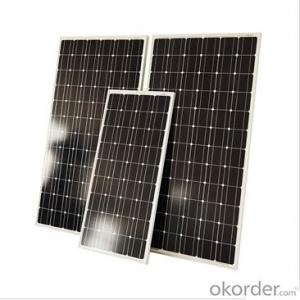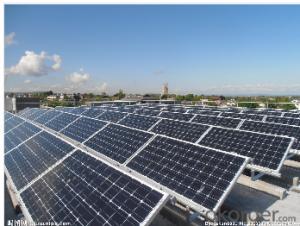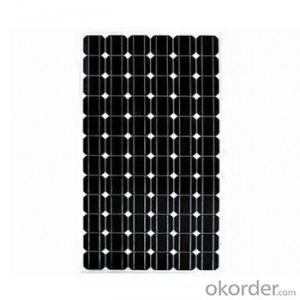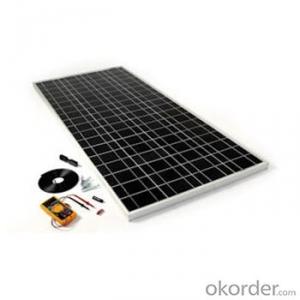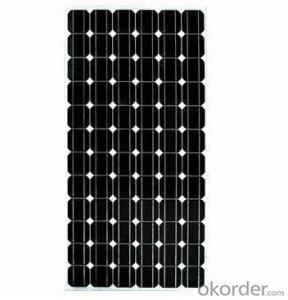Solar Panels West Sussex - Solar Monocrystalline Series Panels 180w
- Loading Port:
- Shanghai
- Payment Terms:
- TT OR LC
- Min Order Qty:
- 100 pc
- Supply Capability:
- 50000 pc/month
OKorder Service Pledge
OKorder Financial Service
You Might Also Like
Introduction of Solar Monocrystalline Series Panels
CNBM Solar photovoltaic (PV) Panel is designed for large electrical power requirements. It is the optimal choice for both on-grid and off-grid power systems. CNBM Solar panel offers high performance of power per square foot of solar array. Monocrystalline silicon(c-Si): often made using the Czochralski process. Single-crystal wafer cells tend to be expensive, and because they are cut from cylindrical ingots, do not completely cover a square solar cell module without a substantial waste of refined silicon. Hence most c-Si panels have uncovered gaps at the four corners of the cells.
Characteristics of Solar Monocrystalline Series Panels
I Solar Cell : High efficiency crystalline solar cell. Even if under the weak light, the solar module can produce maximum power output.
II Tempered glass (toughened glass): Anti-reflecting coating and high transmission rate glass increase the power output and mechanical strength of solar module.
III EVA and TPT: Using high quality EVA and TPT to prevent destroying and water.
IV AI frame: Without screw, corner connection. 6 holes on the frame can be installed easily.
V Junction box: Multi function junction box with water proof.
VI Long lifetime: ≥25 years; Less power decrease
VII Good performance of preventing from atrocious weather such as wind and hails.
VIII Resisting moisture and etching effectively, not effected by geology.
Standard Test Conditions of Solar Monocrystalline Series Panels
The opto-electrical specifications shown below are stabilized values being measured at Standard Test Conditions, Irradiance: 1000W/m2, Spectrum: AM1.5 at 25°C, The info below is subject to manufacturing tolerances. Where appropriate minutes of measurement are available and are used for the dimensioning of the installation.
Advantages of Solar Monocrystalline Series Panels
• CNBM Solar performance guarantees for 25 years
• 12 years guarantee for workmanship
• Timeliness of delivery
CNBM International Corporation's products including Monocrystalline Solar Panel, Polycrystalline Solar Panel have received and enjoyed famous reputation in many countries and regions in the world .As a solar panel supplier in China, we strive to provide our customers with excellent service, superior products and unmatched value.
ITEM NO. | NBJ-180M | NBJ-175M | NBJ-170M |
Maximum Power (W) | 180 | 175 | 170 |
Optimum Power Voltage (V mp) | 35.14 | 35.14 | 35.14 |
Optimum Operating Current (I mp): | 5.13 | 4.99 | 4.85 |
Open Circuit Voltage (Voc) | 43.2 | 43.2 | 43.2 |
Short Circuit Current (ISC) | 5.48 | 5.32 | 5.18 |
Cell Efficiency (%) | 17% | 16.50% | 16.03% |
Module Efficiency (%) | 14% | 13.70% | 13.32% |
FF (%) | 70-76% | ||
Warranty | 90% of 10 years, 80% of 25 years. | ||
Standard Test Conditions | AM1.5 1000W/m2 25 +/-2°C | ||
Bypass Diode Rating (A) | 12 | ||
Cable & Connector Type | Pass the TUV Certificate | ||
Size of Module (mm) | 1580*808*35 | ||
Solar Cell | 125*125 Mono | ||
Backing (Material) | TPT | ||
Frame (Material Corners, etc.) | Aluminum-alloy | ||
Number of Cell (PCS) | 6*12 | ||
N/W(KG) | 15.5 | ||
Junction Box Type | Pass the TUV Certificate | ||
Tolerance Wattage (e.g. + /-5%) | ±3% | ||
Front Glass Thickness (mm) | 3.2 | ||
Surface Maximum Load Capacity | 5400Pa | ||
Allowable Hail Load | 23m/s, 7.53g | ||
Packing | 1*20'GP | 364pcs | |
1*40'GP | 722pcs | ||
Temperature Coefficients of ISC(%): | 0.04 | ||
Temperature Coefficients of Voc(%): | -0.38 | ||
Temperature Coefficients of Pm(%): | -0.47 | ||
Temperature Coefficients of IM(%): | 0.04 | ||
Temperature Coefficients of VM(%): | -0.38 | ||
Temperature Range | -40°C to +85°C | ||
FAQ
We have organized several common questions for our clients,may help you sincerely:
1.What’s price per watt?
A: It’s depends on the quantity, delivery date and payment terms of the order. We can talk further about the detail price issue. Our products is high quality with lower price level.
2. Can you tell me the parameter of your solar panels?
We have different series of cells with different power output, both from c-si to a-si. Please take our specification sheet for your reference.
3.How do you pack your products?
We have rich experience on how to pack the panels to make sure the safety on shipment when it arrives at the destination.
4.Can you do OEM for us?
Yes, we can.
5.How long can we receive the product after purchase?
In the purchase of product within three working days, We will arrange the factory delivery as soon as possible. The perfect time of receiving is related to the state and position of customers. Commonly 7 to 10 working days can be served.
- Q: What maintenance is required for solar panels?
- Solar panels require minimal maintenance. Regular cleaning of the panels to remove dirt, debris, and any shading objects is necessary to ensure optimal performance. Additionally, inspecting the panels for any damage or malfunctioning components is recommended. It is also important to monitor the system's performance and keep track of any changes. Overall, solar panels are designed to be durable and require very little maintenance.
- Q: Can solar panels be used in areas with high levels of wildlife activity?
- Yes, solar panels can be used in areas with high levels of wildlife activity. However, it is important to take certain precautions to minimize potential impacts on wildlife. This can include implementing proper installation techniques, such as avoiding nesting sites or wildlife corridors, and using deterrents to prevent wildlife from damaging the panels. Additionally, incorporating habitat-friendly designs and partnering with local conservation organizations can help mitigate any potential negative effects on wildlife populations.
- Q: Are solar panels a good investment?
- Yes, solar panels are a good investment. They provide long-term financial benefits through reduced energy bills, potential tax incentives, and increased property value. Additionally, they contribute to a cleaner environment by reducing reliance on non-renewable energy sources.
- Q: How do solar panel power systems work?
- Solar panel power system contains off-grid and on-grid types, for off-grid type: the panels convert solar energy into electric power and the power will be stored in batteries through controller at daytime, when the loads need power, the battery will charge them through controller; the on-grid system is almost the same, but without battery, it will connect with city grid.
- Q: Can you please tell me how much a solar panel costs?Please back up your info with a website.
- If okorder /.. Low-cost crystalline panel manufacturers such as Suntech are believed to have costs in the $.50/watt range today - making it $300 for a 200-watt panel. That doesn't mean that one can buy a panel for that price, of course. If you mean a DIY panel from purchased solar cells, the cost would be closer to $360 for an equivalent-powered panel, not counting the price of the frame, and the labor. A homebuilt panel would not stand up to decades of weather unless one spent even more on the frame. And since such a panel would not have safety certification, it could not legally be connected to the grid in most places. If you meant a water heating panel, please update or post another question - I'm sure people will chime in.
- Q: Im doing a project and i have to persuade some one that solar pannels are great... help ?
- nan
- Q: Can solar panels be installed on greenhouses?
- Yes, solar panels can be installed on greenhouses. In fact, it is a popular practice as it allows for the generation of renewable energy while utilizing the available space on the greenhouse roof. The solar panels can help offset the energy needs of the greenhouse and contribute to a more sustainable and environmentally-friendly operation.
- Q: I need to know where I can buy the parts or find them as scrap to make my own solar panels. Is there a cheap way of buying the panels or can I make them myself.
- Build okorder /
- Q: Can solar panels be installed on a warehouse or industrial facility?
- Yes, solar panels can be installed on a warehouse or industrial facility. In fact, these large structures often have ample roof space, making them ideal for solar panel installations. Installing solar panels on warehouses or industrial facilities can help offset energy costs, reduce carbon emissions, and contribute to a more sustainable energy future.
- Q: I am currently building a house, iv designed it to be as self sustainable as possible, I'm in the process of installing solar panels but as I'm ordering online I was hoping someone here could tell me how many I would need to completely run a 5 bedroom home, just standard household appliances such as fridge and freezers, plasma tvs computers and of course lighting, various things like that, also I'll need power storage as well, some type of large rechargeable battery, any help would be great.
- I am a current solar panel professional worker. I suggest you try to obtain a 34RTS TurbibineIVX solar panel as it will cover all your energy needs.
Send your message to us
Solar Panels West Sussex - Solar Monocrystalline Series Panels 180w
- Loading Port:
- Shanghai
- Payment Terms:
- TT OR LC
- Min Order Qty:
- 100 pc
- Supply Capability:
- 50000 pc/month
OKorder Service Pledge
OKorder Financial Service
Similar products
Hot products
Hot Searches
Related keywords
